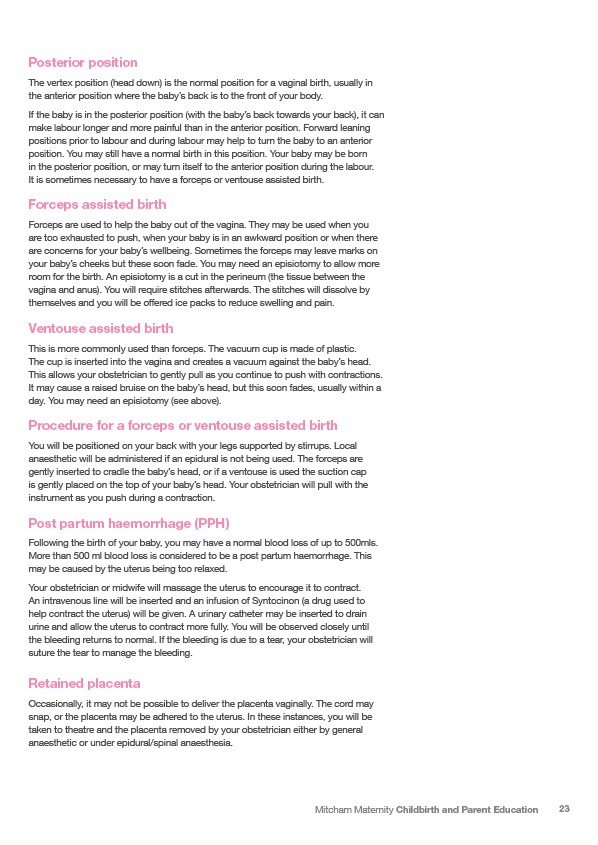
Posterior position
The vertex position (head down) is the normal position for a vaginal birth, usually in
the anterior position where the baby’s back is to the front of your body.
If the baby is in the posterior position (with the baby’s back towards your back), it can
make labour longer and more painful than in the anterior position. Forward leaning
positions prior to labour and during labour may help to turn the baby to an anterior
position. You may still have a normal birth in this position. Your baby may be born
in the posterior position, or may turn itself to the anterior position during the labour.
It is sometimes necessary to have a forceps or ventouse assisted birth.
Forceps assisted birth
Forceps are used to help the baby out of the vagina. They may be used when you
are too exhausted to push, when your baby is in an awkward position or when there
are concerns for your baby’s wellbeing. Sometimes the forceps may leave marks on
your baby’s cheeks but these soon fade. You may need an episiotomy to allow more
room for the birth. An episiotomy is a cut in the perineum (the tissue between the
vagina and anus). You will require stitches afterwards. The stitches will dissolve by
themselves and you will be offered ice packs to reduce swelling and pain.
Ventouse assisted birth
This is more commonly used than forceps. The vacuum cup is made of plastic.
The cup is inserted into the vagina and creates a vacuum against the baby’s head.
This allows your obstetrician to gently pull as you continue to push with contractions.
It may cause a raised bruise on the baby’s head, but this soon fades, usually within a
day. You may need an episiotomy (see above).
Procedure for a forceps or ventouse assisted birth
You will be positioned on your back with your legs supported by stirrups. Local
anaesthetic will be administered if an epidural is not being used. The forceps are
gently inserted to cradle the baby’s head, or if a ventouse is used the suction cap
is gently placed on the top of your baby’s head. Your obstetrician will pull with the
instrument as you push during a contraction.
Post partum haemorrhage (PPH)
Following the birth of your baby, you may have a normal blood loss of up to 500mls.
More than 500 ml blood loss is considered to be a post partum haemorrhage. This
may be caused by the uterus being too relaxed.
Your obstetrician or midwife will massage the uterus to encourage it to contract.
An intravenous line will be inserted and an infusion of Syntocinon (a drug used to
help contract the uterus) will be given. A urinary catheter may be inserted to drain
urine and allow the uterus to contract more fully. You will be observed closely until
the bleeding returns to normal. If the bleeding is due to a tear, your obstetrician will
suture the tear to manage the bleeding.
Retained placenta
Occasionally, it may not be possible to deliver the placenta vaginally. The cord may
snap, or the placenta may be adhered to the uterus. In these instances, you will be
taken to theatre and the placenta removed by your obstetrician either by general
anaesthetic or under epidural/spinal anaesthesia.
Mitcham Maternity Childbirth and Parent Education 23